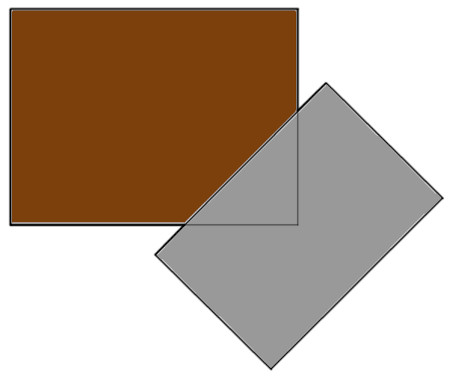“I have always been of the opinion that unpopularity earned by doing what is right is not unpopularity at all but glory.” — Cicero
For the Record

In 2011, Monash University mathematician Burkard Polster set out to answer a practical question: How precariously can you place a laptop computer on a crowded bedside table so that it will take up minimal space without falling off?
Assuming that both the table and the laptop are rectangular, and that the laptop’s center of gravity is its midpoint, it turns out that the optimal placement occurs when the laptop’s midpoint coincides with one of the table’s corners and the footprint is an isosceles right triangle, as above.
This also assumes that the table is reasonably sized. But then, if it’s tiny, then balancing a laptop on it probably isn’t your biggest problem.
(Burkard Polster, “Mathematical Laptops and Bedside Tables,” Mathematical Intelligencer 33:2 [July 2011], 33-35.)
Stoicisms

Meditations of Marcus Aurelius:
- “I am constantly amazed by how easily we love ourselves above all others, yet we put more stock in the opinions of others than in our own estimation of self. … How much credence we give to the opinions our peers have of us and how little to our very own!”
- “Drama, combat, terror, numbness, and subservience — every day these things wipe out your sacred principles, whenever your mind entertains them uncritically or lets them slip in.”
- “A cucumber is bitter. Throw it away. There are briars in the road. Turn aside from them. This is enough. Do not add, ‘And why were such things made in the world?'”
- “Do not then consider life a thing of any value. For look at the immensity of time behind thee, and to the time which is before thee, another boundless space. In this infinity then what is the difference between him who lives three days and him who lives three generations?”
- “I, who have never wilfully pained another, have no business to pain myself.”
- “He who fears death either fears to lose all sensation or fears new sensations. In reality, you will either feel nothing at all, and therefore nothing evil, or else, if you can feel any new sensations, you will be a new creature, and so will not have ceased to have life.”
- “First get at the nature and quality of the original cause, separate it from the material to which it has given shape, and study it; then determine the possible duration of its effects.”
- “Take it that you have died today, and your life’s story is ended; and henceforward regard what further time may be given you as an uncovenanted surplus, and live it out in harmony with nature.”
- “To pursue the unattainable is insanity, yet the thoughtless can never refrain from doing so.”
“The woes you have had to bear are numberless because you were not content to let Reason, your guide and master, do its natural work. Come now, no more of this!”
In a Word
scrutator
n. a person who investigates
ambagical
adj. obscure
butyraceous
adj. of the nature of, resembling, or containing butter
delibation
n. a slight knowledge of something
In “The Adventure of the Six Napoleons,” Sherlock Holmes makes an enigmatic allusion: “You will remember, Watson, how the dreadful business of the Abernetty family was first brought to my notice by the depth which the parsley had sunk into the butter upon a hot day.”
He says nothing more. In The New Annotated Sherlock Holmes, Leslie Klinger writes, “Numerous pastiches and analyses of the ‘Abernetty business’ have been written and are surveyed in detail in William Hyder’s ‘Parsley and Butter: The Abernetty Business.’ Hyder concludes, without foundation, that no less than murder was involved. Is it not equally likely that a business — perhaps an inn or tavern — run by the Abernetty family was ‘dreadful’ (that is, kept in poor sanitation), and that that condition was first brought to Holmes’ notice by the butter having been left out on a hot day? The connection between this observation and the ensuing investigation remains undetermined. A number of scholars consider whether and how fast parsley will sink into butter. Not surprisingly, they do not agree.”
Respects

Cruising the Mediterranean in 1962, the American aircraft carrier USS Independence came upon a full-rigged sailing ship with a striped hull, a teak deck, and an ornamented bow and stern.
With a light signal the carrier asked, “Who are you?”
The ship answered, “Training ship Amerigo Vespucci, Italian navy.”
The Independence replied, “You are the most beautiful ship in the world.”
Traction

In 1967, a foot powder was elected mayor of a town in Ecuador.
During municipal elections in Picoazá, an urban parish of 4,000 people on the Pacific coast, a foot deodorant company called Pulvapies offered the advertising slogan “Vote for any candidate, but if you want well-being and hygiene, vote for Pulvapies.”
That’s innocent enough. But “on the eve of the election, the company distributed a leaflet the same size and color as the official voting papers, saying: ‘For Mayor: Honorable Pulvapies,'” reported the New York Times.
The result was that, when the votes were counted, the foot powder had been elected by a clear majority. Dozens of defeated candidates threatened to sue the pharmaceutical company that ran the ads, leaving the national election tribunal to sort out the mess. I haven’t been able to learn the outcome. It’s a shame — that’s one candidate that would have served both left and right.
(Thanks, Ethan.)
Seeking
On July 19, 1695, this notice appeared on page 3 of a weekly London pamphlet:
A Gentleman about 30 Years of Age, that says he had a Very Good Estate, would willingly Match himself to some Good Young Gentlewoman that has a Fortune of 3000l. or thereabouts, and he will make Settlement to Content.
It’s believed to be the world’s first lonely hearts ad. The pamphlet’s publisher, John Houghton, wrote, “‘Tis probable such Advertisements may prove useful.”
(Francesca Beauman, Shapely Ankle Preferr’d, 2011.)
Decisions
A book lover is thinking of buying six books from a group of eight. The price of each book is a whole number of dollars, and none is less than $2. The prices are such that each possible selection of six books would cost the buyer a different sum. In the end he can’t make up his mind and buys all eight books. What is the smallest amount he must pay?
Each choice of six books from the group of eight leaves two behind. The price of each possible omitted pair must be unique, or else the corresponding sextets would cost the same, which we know is not the case. So we can solve the problem by working out the lowest possible price for each book that ensures that every possible pair has a distinct price.
The three lowest possible prices are $2, $3, and $4. That’s fine so far, but the next book can’t cost $5, because then we’d have two pairs with the same value (5 + 2 = 3 + 4). So we jump to 6 and see if that works. By looking always for the smallest possible next higher price for each volume, we’ll arrive at 2, 3, 4, 6, 9, 14, 22, 31, which gives a total price of $91.
But, interestingly, that’s not the answer! After Roland Sprague published this puzzle in his 1963 book Recreation in Mathematics, he found the solution 2, 3, 4, 6, 10, 15, 20, 30, which totals 90. And Fritz Düball later found 2, 3, 4, 6, 10, 16, 21, 26, which totals 88. Is that the lowest sum possible? Sprague doesn’t claim that it is, and I’ve not seen this problem elsewhere than in his book.
06/19/2022 UPDATE: Reader Michael Küll wrote a program to search for all solutions in a reasonable range. There are four solutions with a total amount less than or equal to $91:
88 : 2 3 4 6 10 16 21 26 90 : 2 3 4 6 10 15 20 30 91 : 2 3 4 6 9 14 22 31 91 : 2 3 4 6 10 17 22 27
So Düball’s solution is indeed the best possible. (Thanks, Michael.)
The Brautigan Library
A reader let me know about this: In Vancouver, Washington, there’s a library for “unwanted” manuscripts — manuscripts that no publisher wanted to publish. The Brautigan Library was inspired by Richard Brautigan’s 1971 novel The Abortion: An Historical Romance 1966, which describes a library for “the unwanted, the lyrical and haunted volumes of American writing.” Authors could place their manuscripts anywhere they liked on the library’s shelves, happy to have them preserved there though no readers could find them.
Inspired by this, in 1990 Todd Lockwood, of Burlington, Vermont, started The Brautigan Library, inviting submissions of unpublished manuscripts and encouraging visitors to read them. Lockwood’s library closed in 2005, but in 2010 its contents were taken from storage and moved to Vancouver, where John Barber, a faculty member at Washington State University, now curates it. It currently contains more than 300 manuscripts, and Barber now accepts electronic submissions. You can browse the catalog here.
The French writer David Foenkinos has written a novel in which a librarian reads Brautigan’s book and decides to create Brautigan’s library as part of the municipal library that he manages in a little town in Brittany. It’s called “Le mystère Henri Pick.”
(Thanks, January.)
Dependent Claws

The first motion picture to feature a live cat is believed to be this 1894 short in which French physiologist Étienne-Jules Marey drops an inverted feline to watch it land on its feet.
When the experiment was published in Nature in 1894, the editors wrote, “The expression of offended dignity shown by the cat at the end of the first series indicates a want of interest in scientific investigation.”
